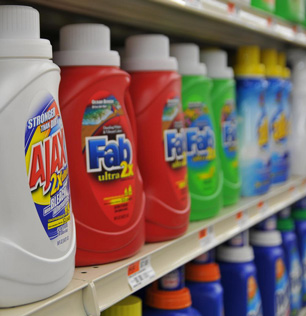Nitrilotriacetic Acid (NTA)

NTA can be found in some laundry detergents.
Nitrilotriacetic Acid (NTA) is a chemical used in laundry detergent, as a scale prevention method for boilers, in photography, leather tanning, in textile and paper manufacturing, and as a medical treatment for manganese poisoning. Its use in detergents was banned in the 1970s, but resumed in the 1980s to replace phosphates that were then being banned.
According to a 2011 report from the National Toxicology Program, “the general population may be exposed through ingestion of drinking water or dermal contact with products containing nitrilotriacetic acid or its salts.”
Health Effects of Nitrilotriacetic Acid
Nitrilotriacetic Acid is mildly toxic with acute exposure. Animal studies have shown long term effects including kidney damage, blood sugar changes and skeletal issues. It is also a potential human carcinogen, with the International Agency for Research on Cancer reporting “sufficient evidence” of carcinogenicity in animal tests.
Water Treatment for Nitrilotriacetic Acid
The EPA recommends activated carbon for the treatment of nitrilotriacetic acid.
Sources: EPA, National Toxicology Program, WHO, IARC, Image: Flickr, author: Pixel Drip
Site Index
Filtration Systems
- Aeration for Iron & Sulfide
- Backwashing Filters
(whole house & well units)
- Chlorine & Chemical Injectors
- Countertop Water Filters
- Emergency Filters
- Garden Hose Filters
- Reverse Osmosis, Residential
- Reverse Osmosis, Commercial
- Shower Filters
- Specialty Filters
- Ultraviolet Systems
- Undersink Filters
- Water Softeners
- Whole House Filters
Cartridges
Parts
- Replacement Parts
- Faucets
- Filter Media
- Fittings
- Housings
- O-rings
- Pumps
- Pura UV
- R.O. Parts
- R.O. Tanks
- R.O. Booster Pump
- VIQUA UV